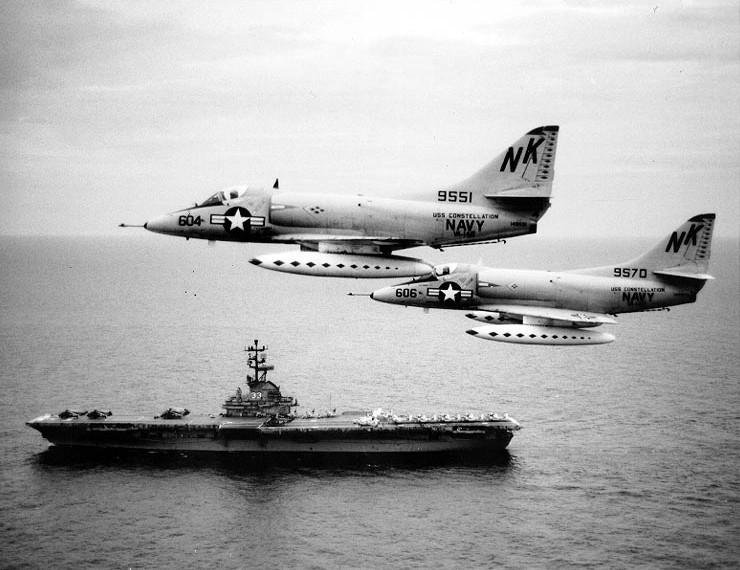Two Douglas A-4C Skyhawk (BuNos. 149551 and 149570) of attack squadron VA-146 Blue Diamonds fly past the anti-submarine carrier USS Kearsarge (CVS-33) on August 12, 1964. VA-146 was deployed as part of Carrier Air Wing 14 (CVW-14) on board the carrier USS Constellation (CVA-64) during 1964/65 to the Western Pacific. Planes of CVW-14 took part in the August 1964 strikes against North Vietnamese PT-boat bases as a result of the Tonkin Gulf Incident. Photo by United States Navy/
Wikipedia
WASHINGTON, Aug. 5, 1964 (UPI) Two American planes were shot down by anti-aircraft fire from ground batteries. Their pilots were presumed lost.
Besides knocking out a large portion of North Viet-Nam's patrol fleet, the U.S. Navy planes from the carriers Ticonderoga and Constellation blew up an oil depot and other base facilities.
The low-level air attacks were carried out over a period of about five hours, from noon to 5 p.m. Viet-Nam time (midnight to 5 a.m. EDT).
The action, the first against North Viet-Nam itself, was carried out on direct orders of President Johnson as retaliation for two more unprovoked attacks by North Viet-Namese patrol boats on U.S. destroyers patrolling international waters. The attacks occurred yesterday morning but were not announced until last night.
Johnson in ordering the strike-back assured the nation and the world that the United States "still seeks no wider war" in Viet-Nam and that its response to Red provocations "for the present will be limited and fitting."
He won unanimous backing from the legislative leaders of both parties in his appeal for a congressional resolution endorsing any necessary action to deter further Communist attacks in Southeast Asia.
Results of the air action were announced this morning by Defense Secretary Robert S. McNamara.
McNamara also announced major air, naval and troop movements on a global scale to reinforce the U.S. position in Southeast Asia.
He said an aircraft carrier task group is being dispatched from the U.S. Pacific Coast to the Western Pacific and squadrons of intercepter and fighter-bomber planes are being moved from the United States to bases in the Western Pacific.
An antisubmarine task force has been moved into the South China Sea; "selected Army and Marine forces have been alerted" for possible movement on short notice and U.S. warplanes have been dispatched to bases in South Viet-Nam and neighboring Thailand.
This redeployment of what President Johnson called America's "awesome" military power was clearly intended to put U.S. armed forces in readiness for any new move which North Viet-Nam or its big Red neighbor, Communists China, might decide to risk.
McNamara in reply to questions said he felt that today's air strikes accomplished the primary U.S. objective of "very clearly demonstrating" to the Communists that the Untied States will not tolerate attacks on its naval vessels on the high seas.
Whether further attacks on North Viet-Namese bases will be made "depends entirely on North Viet-Nam," the defense secretary said.
McNamara said the carrier-based U.S. planes flew 64 sorties - that is, single flights - in bad weather.
"Two of our aircraft were lost and two were damaged," he said. "All others have been recovered safely."
Pending intelligence analysis of the reports of the returning U.S. pilots, the defense secretary declined to estimate the extent of the damage inflicted on the North Viet-Namese shore bases.
But he said that the oil depot, representing 10% of North Viet-Nam's petroleum storage capacity, was 90% destroyed. Smoke from the burning oil tanks rose to 14,000 feet.
McNamara identified the targets as the PT boat bases of Hon Gay, Loc Chao, Phuc Loi and Quang Khe, and the Vinh oil depot.
McNamara said he thought the pilots of the two American planes were definitely lost. The planes were knocked down by heavy anti-aircraft fire and plunged in the sea.
U.S. planes were not opposed by anti-aircraft missiles, he said.
He was asked whether any action was taken against anti-aircraft emplacements. He said no - that the targets were only the torpedo boat facilities.
The Secretary said no civilian population centers were located close to the North Viet-Namese bases that were attacked.
Asked whether the American strike accomplished the intended U.S. mission, McNamara's response was that it "very clearly demonstrates" to the North Viet-Namese the intention of the United States to operate unmolested on the high seas.
McNamara asserted that the destroyers Maddox and C. Turner Joy, which were attacked yesterday by an estimated six Communist torpedo boats, were continuing their patrol in the Gulf of Tonkin today.















